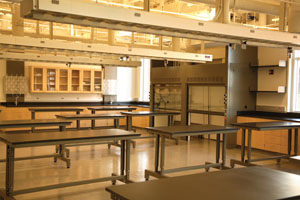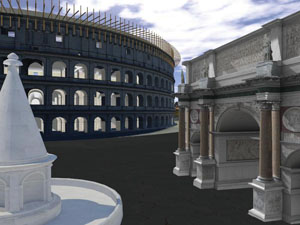
Department of Systems and Information
Engineering, and graduate student
Matthew Bolton, designed this synthetic
vision system, computerized representations
of terrain designed for placement in cockpit
navigation and primary flight displays, to
help enhance pilots' awareness of terrain,
particularly under low-visibility conditions.
For such displays, it is critical that the pilot
be able to judge accurately his or her position
relative to the represented terrain. Professor
Bass's research will determine which display
features help to achieve this goal.
As scholars and teachers, the faculty members of the University of Virginia are deeply engaged in addressing the challenges of our time, helping us see the world in fresh ways. Take a study by William H. Lucy, the Lawrence Lewis, Jr., Professor of Architecture and David L. Phillips of the Department of Urban and Environmental Planning, for example. Their work showed that, contrary to popular belief, middle- and upper-income whites have not left the cities for the suburbs and that the per capita income of non-Hispanic whites is substantially higher in cities. At the same time, they found the value of housing in cities is on the rise, as is condominium construction. As a whole, they argue, the nation's cities are staging a remarkable comeback.
Our faculty members have both the standing and the resources to take on vexing national issues. The Miller Center of Public Affairs provides an outstanding service to the country, having convened a series of distinguished commissions during the last quarter century to address issues such as federal election reform, the separation of powers, and the selection of federal judges. Now under the leadership of former Virginia Governor Gerald L. Baliles (Law '67), the Miller Center announced the formation of the National War Powers Commission, a private bipartisan panel led by former Secretaries of State James A. Baker III and Warren Christopher. The commission will examine how the U.S. Constitution allocates the powers of beginning, conducting, and ending war.
IATH SECURES IBM GRANTA grant from IBM will place the University at the forefront of a worldwide effort to develop academic applications for IBM's Cell Broadband Engine, an advanced processor that offers ultrafast performance for virtual reality, real-time video chat and other image-intense computer environments. The U.Va. team is led by Bernard Frischer, director of the Institute for Advanced Technology in the Humanities and professor of art history and classics, and Grigori R. Humphreys, assistant professor of computer science. |
In some cases the line between public service and research is hard to define. University of Virginia law professor Thomas Hafemeister and psychiatry professor Shelly Jackson received a grant of nearly $300,000 this year from the National Institute of Justice to investigate financial abuse and other forms of mistreatment of the elderly in Virginia. An estimated one to two million Americans age sixty-five and older�about 4 to 6 percent of the nation's elderly�are injured, exploited, or otherwise mistreated by someone they depend on for care or protection each year. Professors Hafemeister and Jackson will contact recent victims of abuse about the cause of the abuse and the effectiveness of the state's response.
At the Leading Edge of Digital Scholarship
Research conducted at the University increasingly has a digital component. For scholars, the Internet offers a host of compelling advantages. It provides computational tools to organize, visualize, and analyze ideas in ways that were unimaginable just a decade ago. It transforms what had primarily been a solitary activity into a collaborative one. And it gives researchers the ability to present information with unequaled immediacy. Through organizations such as the Institute for Advanced Technology in the Humanities (IATH) and the Center for Digital History (CDH), the University has been a leader in harnessing the power of the Web for research, education, and public service. A number of projects launched or under development this year illustrate this point.

Nanotechnology
When research is conducted on materials at
scales of a billionth of a meter, a stray vibration
or even the slightest bit of electrical interference
can be disastrous. This is one concern
addressed in the planning for Wilsdorf Hall,
the new $43.4 million Engineering School
building, which opened in November 2006.
Designed to suppress vibration and isolate
electrical impulses, it has already proved to
be a powerful attraction for new faculty and
graduate students from various disciplines.
David Gies, Commonwealth Professor of Spanish, launched an innovative Web site that uses Spanish-language films to teach language and culture. Aimed at high school students and their teachers, Cine con Clase! features one- to two-minute clips from twenty-five different films along with additional content, ranging from scripts to vocabulary to suggested activities and exercises. In developing the site, Professor Gies worked with Ruth M. Ferree, assistant professor of foreign language education at the Curry School of Education, and Michael Tuite, head of the Digital Media Lab at the Robertson Media Center and, through a series of summer institutes, with high school teachers from throughout the Commonwealth. The construction of the site was funded by a $250,000 grant from the National Endowment for the Humanities.
A $186,000 grant from the NEH allowed Professor Gies's colleague, Deborah Parker, professor of Italian, to upgrade her highly regarded World of Dante Web site, which she created eight years ago as a fellow with IATH. The site, focusing on Dante's Divine Comedy, features searchable text (both in Italian and English), illustrations, and other visual materials. The extended World of Dante will boast a new interface design, courtesy of researchers at Microsoft's New Media Research Laboratory, additional engravings, maps, iconography, photos, and a virtual tour through the Inferno. Music professor Paul Walker is recording all the hymns mentioned in the poem that inspired the poet, sung by the Charlottesville early music ensemble Zephyrus. Those, too, will be posted on the site, which is at www3.iath.virginia.edu/dante/.
REBUILDING STRONG BONESMost people begin life with good bones. But time and trauma take their toll. Age makes bones brittle, while diseases like osteoporosis can make them soft or change their shape. Tissue engineers such as Edward Botchwey, assistant professor of biomedical engineering, are devising new ways not simply to repair bone but to restore it to health. They begin with a three-dimensional, biodegradable matrix, seeded with bone cells and infused with the nutrients and molecules that enable bone cells to organize themselves into functioning bone tissue. Professor Botchwey is finding ways to encourage these bone grafts to develop their own blood supply, increasing the likelihood of success. |
Faculty members are also at the forefront of investigating the potential of the Internet to foster new forms of research and scholarship. This year, the Andrew W. Mellon Foundation awarded Jerome McGann, University Professor and the John Stewart Bryan Professor of English, almost $800,000 to develop new technological tools for interpreting and analyzing works of art and literature. Professor McGann is a widely recognized leader in this field. As a founding member of IATH, he developed the highly influential Web site The Complete Writings and Pictures of Dante Gabriel Rossetti: A Hypermedia Archive, at www.rossettiarchive.org.

Rome Reborn 1.0 begins outside with
details of the Arch of Constantine (right)
and the Meta Sudans fountain (left).
Perhaps no other event this year highlights Virginia's leadership in digital scholarship better than the first public viewing of Rome Reborn 1.0, a ten-year project now based at the University of Virginia. Rome's Mayor Walter Veltroni officiated at the ceremony from Palazzo Senatorio. An international team of archaeologists, architects, and computer specialists from Italy, the United States, Britain, and Germany, led by IATH director Bernard Frischer, professor of art history and classics, employed laser scanners and other high-tech tools to simulate contemporary cities and to build the biggest, most complete simulation of a historic city ever created.
Rome Reborn 1.0 shows almost the entire city within the thirteen-mile-long Aurelian Walls as it appeared in A.D. 320. Users can navigate through the 3-D model with complete freedom, moving up, down, left, and right at will. They can enter important public buildings such as the Roman Senate House, the Coliseum, or the Temple of Venus and Rome, the ancient city's largest place of worship. Visit www.romereborn.virginia.edu to experience the simulation of ancient Rome and its structures.
Presidential Honors for Outstanding Public Service
care to those in need in southwest Virginia. This year, the University of Virginia was named one of ten national finalists for the U.S. President's Higher Education Community Service Award for Excellence in General Community Service. The awards program cited five initiatives that exemplify the University's commitment to community service:
|
